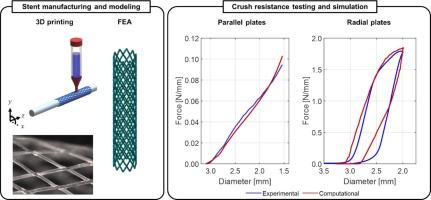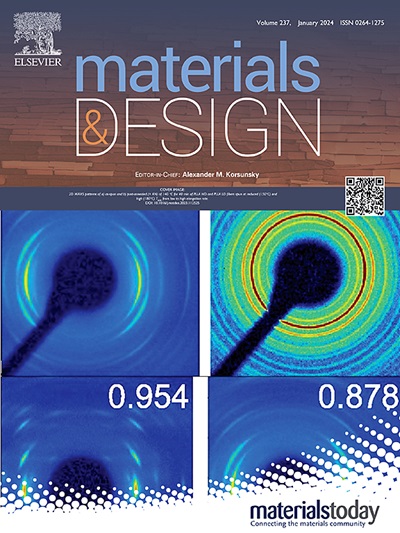3D printed polymeric stent design: Mechanical testing and computational modeling
IF 7.6
2区 材料科学
Q1 MATERIALS SCIENCE, MULTIDISCIPLINARY
引用次数: 0
Abstract
Polymer-based bioresorbable scaffolds (BRS) aim to reduce the long-term issues associated with metal stents. Yet, first-generation BRS designs experienced a significantly higher rate of clinical failures compared to permanent implants. This prompted the development of alternative scaffolds, such as the poly(L-lactide-co-ε-caprolactone) (PLCL) solvent-casted stent, whose mechanical performance has yet to be addressed. This study examines the mechanical behavior of this novel scaffold across a wide range of parallel and radial compression diameters. The analysis highlights the scaffold’s varying responses under different loading conditions and provides insights into interpreting simulation model parameters to accurately reflect experimental results.
Stents demonstrated a parallel crush resistance of 0.11 N/mm at maximum compression, whereas the radial forces were significantly higher, reaching up to 1.80 N/mm. Additionally, the parallel test keeps the stent in the elastic regime, with almost no regions exceeding 50 MPa of stress, while the radial test causes significant structural deformation, with localized plastic strain reaching up to 30 %. Results showed that underestimating yield strain in computational models leads to discrepancies with experimental results, being 5 % the most accurate value for matching computational and experimental results for PLCL solvent-casted stents.
This comprehensive approach is vital for optimizing BRS design and predicting clinical performance.

3D 打印聚合物支架设计:机械测试和计算建模
基于聚合物的生物可吸收支架(BRS)旨在减少与金属支架相关的长期问题。然而,与永久性植入物相比,第一代生物吸收支架设计的临床失败率要高得多。这促使了替代支架的开发,例如聚(L-乳酸-co-ε-己内酯)(PLCL)溶剂铸造支架,其机械性能尚待研究。本研究考察了这种新型支架在广泛的平行和径向压缩直径范围内的机械性能。该分析强调了支架在不同加载条件下的不同反应,并为解释仿真模型参数以准确反映实验结果提供了启示。支架在最大压缩时的平行抗压强度为 0.11 牛顿/毫米,而径向力则明显更高,可达 1.80 牛顿/毫米。此外,平行试验使支架保持在弹性状态,几乎没有应力超过 50 兆帕的区域,而径向试验则会导致明显的结构变形,局部塑性应变高达 30%。结果表明,在计算模型中低估屈服应变会导致与实验结果的差异,5% 是 PLCL 溶剂铸造支架计算结果与实验结果相匹配的最准确值。
本文章由计算机程序翻译,如有差异,请以英文原文为准。
求助全文
约1分钟内获得全文
求助全文
来源期刊

Materials & Design
Engineering-Mechanical Engineering
CiteScore
14.30
自引率
7.10%
发文量
1028
审稿时长
85 days
期刊介绍:
Materials and Design is a multi-disciplinary journal that publishes original research reports, review articles, and express communications. The journal focuses on studying the structure and properties of inorganic and organic materials, advancements in synthesis, processing, characterization, and testing, the design of materials and engineering systems, and their applications in technology. It aims to bring together various aspects of materials science, engineering, physics, and chemistry.
The journal explores themes ranging from materials to design and aims to reveal the connections between natural and artificial materials, as well as experiment and modeling. Manuscripts submitted to Materials and Design should contain elements of discovery and surprise, as they often contribute new insights into the architecture and function of matter.
 求助内容:
求助内容: 应助结果提醒方式:
应助结果提醒方式:


